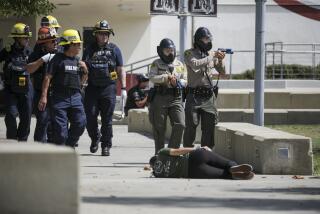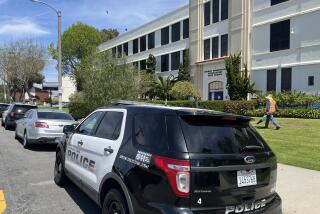Life-and-Death Lessons : Education: County schools may begin teaching students about gun dangers. Says one activist: ‘Too many children are dying.’
- Share via
Ventura County schools, which already use the classroom to warn students against drugs, alcohol and sex, may soon add another subject of concern to the list: guns.
Ventura County Supt. of Schools James F. Cowan is encouraging districts to use teaching materials prepared by the Center to Prevent Handgun Violence, the nonprofit educational arm of a nationwide lobbying group called Handgun Control Inc.
The county office has scheduled a March 10 workshop to inform educators about the center’s curriculum, called Straight Talk About Risks (STAR). Officials say instruction at all grade levels could begin as early as spring.
Adding gun dangers to the curriculum is largely the work of Glenda Lee-Barnard, a Thousand Oaks mother. However, it’s too late for her son, David Lee, 13. Less than two years ago, David was paralyzed from the chest down when a bullet fired by his stepbrother struck him.
David was visiting his father’s home in Claremont, in eastern Los Angeles County, when his stepbrother entered a locked bedroom and took a handgun from a drawer. Police said the youth was taunting David with the gun when it went off.
“Too many children are dying,” said Lee-Barnard, who has since become a gun safety activist. “We’ve got so much gang violence. Violence and anger--kids don’t know what to do with it.”
The curriculum for the STAR program is a 200-page manual filled with activities that teach students about gun dangers, cautioning them not to play with guns or carry them to school. It also shows them how to manage conflicts without violence and how to resist peer pressure.
However, a spokesman for the National Rifle Assn. called the program a subtle attempt to sway impressionable minds toward Handgun Control Inc.’s philosophy.
“They want to abolish handguns, and down the road, all firearms,” said Fred Romero, a Simi Valley-based Southern California field representative for the NRA.
“They are not in it to save lives,” he said. “They have a political agenda.”
Romero is miffed that Cowan’s office didn’t seem interested in the NRA’s version of gun safety education for students. Several months ago, Romero sent the office the NRA’s six-page coloring book featuring Eddie Eagle warning Dick and Jane not to touch a gun they have found and to leave the area and immediately tell an adult.
“All they have is a coloring book,” Cowan said.
The superintendent denied that the county intends to use STAR to sway students’ thinking on the handgun issue.
“Our interest is protection and safety,” he said. “We’re not trying to get out and push one way or the other.”
Judy Seyle, coordinator of the county schools’ health program, said she examined STAR’s curriculum closely and found no mention of Handgun Control Inc. or any evidence that the group’s stand was being promoted.
Nor is the county office foisting STAR upon the districts. Use of the program is voluntary, she said. None of the districts have signed up for it yet. Some are more interested than others, and many know nothing about it.
“Gun safety is something that should be taught in the home,” said Barbara Ryan, director of elementary education for the Conejo Valley Unified School District. Besides, she added, “We already have a jampacked curriculum.”
But Mario Contini, assistant superintendent of educational services for the Fillmore Unified School District, has recommended to the district’s board that it incorporate some of the STAR program into its curriculum.
“We have a real concern about gun violence,” Contini said. “We deal with it all the time.”
Last week a car drove by the high school and one of the occupants pointed a gun at a female student, he said. In the last several years, he said, two students have been caught with guns.
In Oxnard, hostility between two alleged gang members resulted in a shooting death in 1989 outside Channel Islands High School. Arnel Salagubang is serving a state prison sentence of 20 years to life for killing Manuel (Deadeye) Rodriguez.
Nonetheless, Gary Davis, Oxnard Union High School District assistant superintendent, said the high schools don’t have a problem with gun violence because expulsion is the penalty for carrying a gun. In the last five years, eight students have been expelled for gun possession on campus.
STAR’s promoters cite startling statistics about gun violence. Nationwide “an estimated 135,000 students bring guns to school daily,” STAR literature says in a quote from the National School Safety Center in Westlake Village.
Every day in the United States, an average of 10 youths are killed with guns in homicides, suicides and accidental shootings, program promoters say.
In Ventura County, 65 children died in firearm fatalities from 1979-88, according to U.S. Department of Health and Human Services statistics. More recent statistics were not available.
During the last 10 years, the rate of juvenile arrests for homicides, felony assault and weapons possession climbed dramatically in Ventura County, California Department of Justice records indicate.
Statistics do not isolate gun incidents, but records show that the number of juveniles charged locally with assault with a deadly weapon recently increased 11%, from 68 in 1990 to 76 in 1991.
“The seriousness of the violations in juvenile cases has escalated,” Chief Deputy Dist. Atty. Vincent J. O’Neill said. In 1991, three people died in drive-by shootings--the first recorded in the county.
STAR was first tried in Dade County, Fla., in 1989 after a record number of children were killed by handguns the two previous years. Later this year, the program will be launched in schools in Oakland, San Diego, Los Angeles and New York City.
The STAR curriculum goes beyond simply warning kids to stay away from guns, said Nancy Gannon, spokeswoman for the Center to Prevent Handgun Violence’s San Mateo branch.
“It tackles the emotional things about violence--the fear, anger and despair,” she said. At the same time, the curriculum doesn’t steer kids away from target shooting and hunting, she said.
Here’s a sampling of the curriculum: Students in kindergarten through second grade might read and discuss Dr. Seuss’ “The Butter Battle Book” about the Yooks and the Zooks who battle over the issue of buttering bread on the up side or the down side.
Older elementary school children might use role-playing to determine what they would do if someone they knew had a handgun in his backpack. Junior high students might discuss what triggers their anger. Older students might conduct a school poll on gun violence. Or, they might learn the facts about gun violence and vivid medical information on gunshot wounds.
“What a bullet can do is so devastating,” said Lee-Barnard who spends most of her time tending to her wheelchair-bound son and her 5-year-old daughter.
David Lee spent three months in the hospital after the shooting. He now attends public school with the assistance of his specially trained dog, Wendy. He sleeps in the living area of the family’s townhouse because they lack the money to install a lift to transport him upstairs.
The accident caused Lee-Barnard to shelve her plans for graduate school.
“I needed to direct a lot of grief and anger,” she said. The avenue she chose was to “stop this from happening so rampantly in children.”
She threw her energy into two new bills that became law Jan. 1. One makes adults responsible when children are injured from guns that are within easy reach. The other calls for two to four hours of safety training for anyone who buys a gun.
Last year, she and her son went to Sacramento several times to speak about his injury. He occasionally speaks to students about the shooting.
Meanwhile, she paved the way for the STAR program to be offered to county school districts.
Although she backs Handgun Control Inc., the national group headed by Sarah Brady, wife of former presidential Press Secretary James Brady, she isn’t in favor of banning guns. But her message about guns is simple.
“Guns kill kids,” she said.
More to Read
Sign up for Essential California
The most important California stories and recommendations in your inbox every morning.
You may occasionally receive promotional content from the Los Angeles Times.










